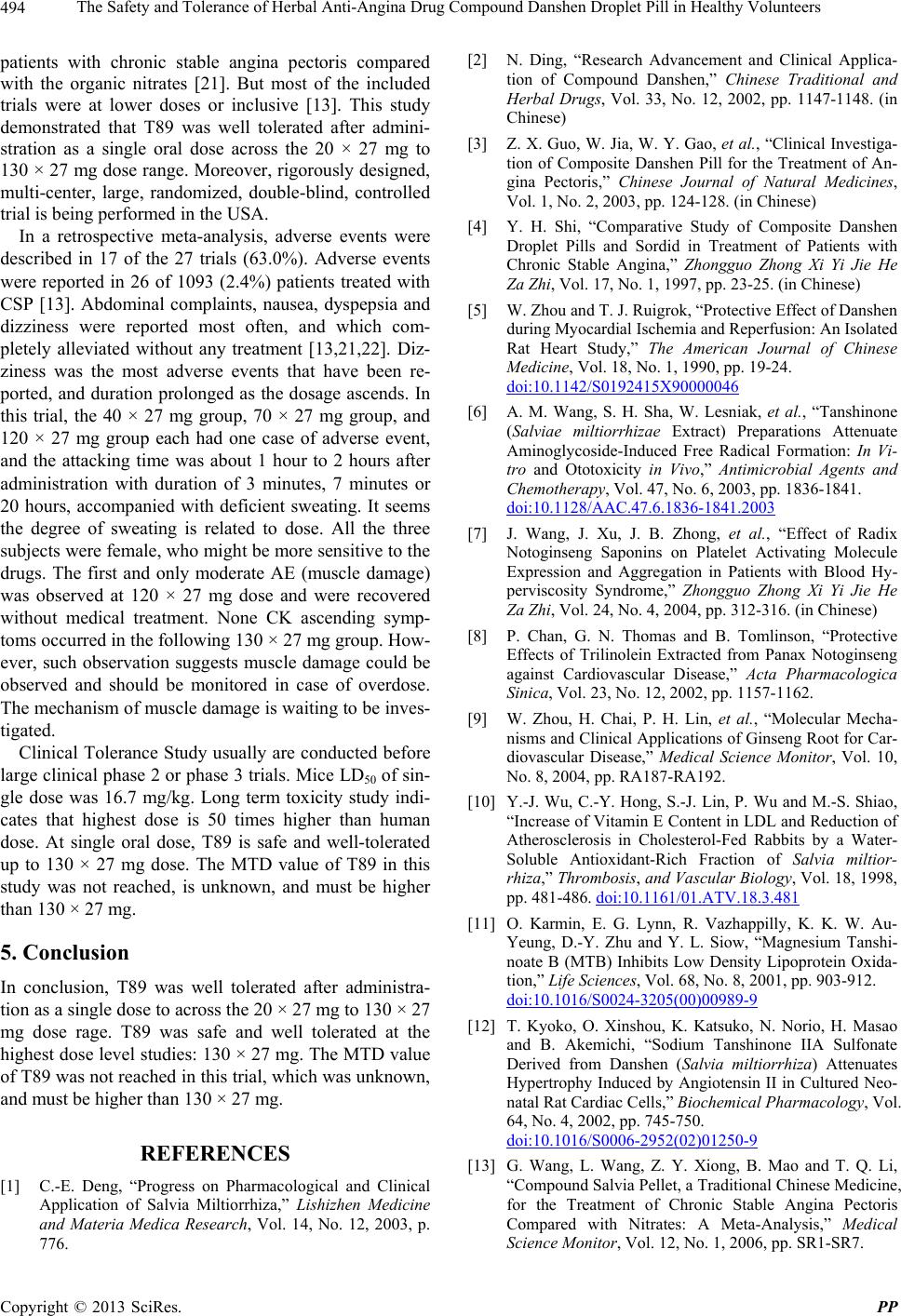
The Safety and Tolerance of Herbal Anti-Angina Drug Compound Danshen Droplet Pill in Healthy Volunteers
494
patients with chronic stable angina pectoris compared
with the organic nitrates [21]. But most of the included
trials were at lower doses or inclusive [13]. This study
demonstrated that T89 was well tolerated after admini-
stration as a single oral dose across the 20 × 27 mg to
130 × 27 mg dose range. Moreover, rigorously designed,
multi-center, large, randomized, double-blind, controlled
trial is being performed in the USA.
In a retrospective meta-analysis, adverse events were
described in 17 of the 27 trials (63.0%). Adverse events
were reported in 26 of 1093 (2.4%) patients treated with
CSP [13]. Abdominal complaints, nausea, dyspepsia and
dizziness were reported most often, and which com-
pletely alleviated without any treatment [13,21,22]. Diz-
ziness was the most adverse events that have been re-
ported, and duration prolonged as the dosage ascends. In
this trial, the 40 × 27 mg group, 70 × 27 mg group, and
120 × 27 mg group each had one case of adverse event,
and the attacking time was about 1 hour to 2 hours after
administration with duration of 3 minutes, 7 minutes or
20 hours, accompanied with deficient sweating. It seems
the degree of sweating is related to dose. All the three
subjects were female, who might be more sensitive to the
drugs. The first and only moderate AE (muscle damage)
was observed at 120 × 27 mg dose and were recovered
without medical treatment. None CK ascending symp-
toms occurred in the following 130 × 27 mg group. How-
ever, such observation suggests muscle damage could be
observed and should be monitored in case of overdose.
The mechanism of muscle damage is waiting to be inves-
tigated.
Clinical Tolerance Study usually are conducted before
large clinical phase 2 or phase 3 trials. Mice LD50 of sin-
gle dose was 16.7 mg/kg. Long term toxicity study indi-
cates that highest dose is 50 times higher than human
dose. At single oral dose, T89 is safe and well-tolerated
up to 130 × 27 mg dose. The MTD value of T89 in this
study was not reached, is unknown, and must be higher
than 130 × 27 mg.
5. Conclusion
In conclusion, T89 was well tolerated after administra-
tion as a single dose to across the 20 × 27 mg to 130 × 27
mg dose rage. T89 was safe and well tolerated at the
highest dose level studies: 130 × 27 mg. The MTD value
of T89 was not reached in this trial, which was unknown,
and must be higher than 130 × 27 mg.
REFERENCES
[1] C.-E. Deng, “Progress on Pharmacological and Clinical
Application of Salvia Miltiorrhiza,” Lishizhen Medicine
and Materia Medica Research, Vol. 14, No. 12, 2003, p.
776.
[2] N. Ding, “Research Advancement and Clinical Applica-
tion of Compound Danshen,” Chinese Traditional and
Herbal Drugs, Vol. 33, No. 12, 2002, pp. 1147-1148. (in
Chinese)
[3] Z. X. Guo, W. Jia, W. Y. Gao, et al., “Clinical Investiga-
tion of Composite Danshen Pill for the Treatment of An-
gina Pectoris,” Chinese Journal of Natural Medicines,
Vol. 1, No. 2, 2003, pp. 124-128. (in Chinese)
[4] Y. H. Shi, “Comparative Study of Composite Danshen
Droplet Pills and Sordid in Treatment of Patients with
Chronic Stable Angina,” Zhongguo Zhong Xi Yi Jie He
Za Zhi, Vol. 17, No. 1, 1997, pp. 23-25. (in Chinese)
[5] W. Zhou and T. J. Ruigrok, “Protective Effect of Danshen
during Myocardial Ischemia and Reperfusion: An Isolated
Rat Heart Study,” The American Journal of Chinese
Medicine, Vol. 18, No. 1, 1990, pp. 19-24.
doi:10.1142/S0192415X90000046
[6] A. M. Wang, S. H. Sha, W. Lesniak, et al., “Tanshinone
(Salviae miltiorrhizae Extract) Preparations Attenuate
Aminoglycoside-Induced Free Radical Formation: In Vi-
tro and Ototoxicity in Vivo,” Antimicrobial Agents and
Chemotherapy, Vol. 47, No. 6, 2003, pp. 1836-1841.
doi:10.1128/AAC.47.6.1836-1841.2003
[7] J. Wang, J. Xu, J. B. Zhong, et al., “Effect of Radix
Notoginseng Saponins on Platelet Activating Molecule
Expression and Aggregation in Patients with Blood Hy-
perviscosity Syndrome,” Zhongguo Zhong Xi Yi Jie He
Za Zhi, Vol. 24, No. 4, 2004, pp. 312-316. (in Chinese)
[8] P. Chan, G. N. Thomas and B. Tomlinson, “Protective
Effects of Trilinolein Extracted from Panax Notoginseng
against Cardiovascular Disease,” Acta Pharmacologica
Sinica, Vol. 23, No. 12, 2002, pp. 1157-1162.
[9] W. Zhou, H. Chai, P. H. Lin, et al., “Molecular Mecha-
nisms and Clinical Applications of Ginseng Root for Car-
diovascular Disease,” Medical Science Monitor, Vol. 10,
No. 8, 2004, pp. RA187-RA192.
[10] Y.-J. Wu, C.-Y. Hong, S.-J. Lin, P. Wu and M.-S. Shiao,
“Increase of Vitamin E Content in LDL and Reduction of
Atherosclerosis in Cholesterol-Fed Rabbits by a Water-
Soluble Antioxidant-Rich Fraction of Salvia miltior-
rhiza,” Thrombosis, and Vascular Biology, Vol. 18, 1998,
pp. 481-486. doi:10.1161/01.ATV.18.3.481
[11] O. Karmin, E. G. Lynn, R. Vazhappilly, K. K. W. Au-
Yeung, D.-Y. Zhu and Y. L. Siow, “Magnesium Tanshi-
noate B (MTB) Inhibits Low Density Lipoprotein Oxida-
tion,” Life Sci ences, Vol. 68, No. 8, 2001, pp. 903-912.
doi:10.1016/S0024-3205(00)00989-9
[12] T. Kyoko, O. Xinshou, K. Katsuko, N. Norio, H. Masao
and B. Akemichi, “Sodium Tanshinone IIA Sulfonate
Derived from Danshen (Salvia miltiorrhiza) Attenuates
Hypertrophy Induced by Angiotensin II in Cultured Neo-
natal Rat Cardiac Cells,” Biochemical Pharmacology, Vol.
64, No. 4, 2002, pp. 745-750.
doi:10.1016/S0006-2952(02)01250-9
[13] G. Wang, L. Wang, Z. Y. Xiong, B. Mao and T. Q. Li,
“Compound Salvia Pellet, a Traditional Chinese Medicine,
for the Treatment of Chronic Stable Angina Pectoris
Compared with Nitrates: A Meta-Analysis,” Medical
Science Monitor, Vol. 12, No. 1, 2006, pp. SR1-SR7.
Copyright © 2013 SciRes. PP